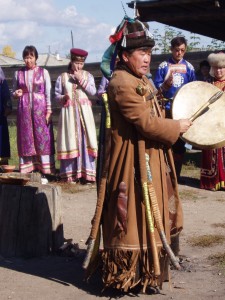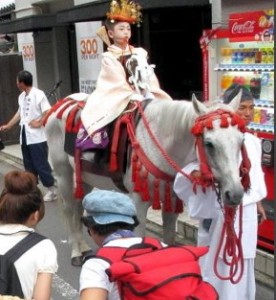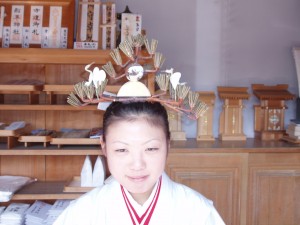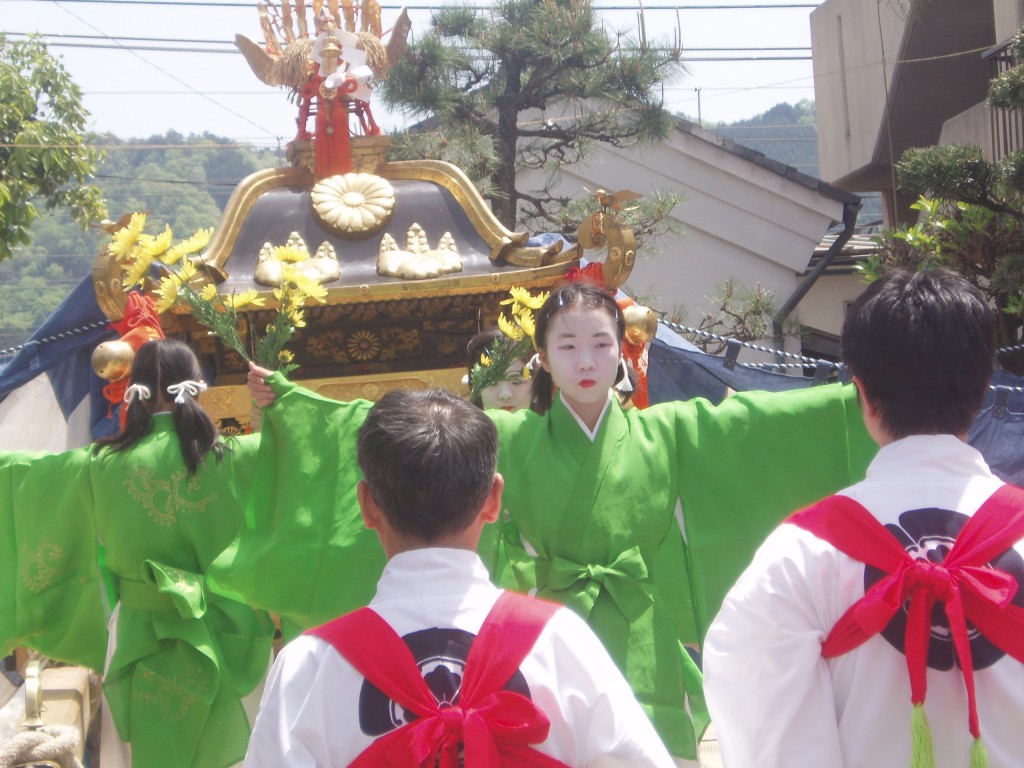
Buryat shaman: Siberian shamanism passed into Japan through Korea.
The Catalpa Bow is the standard account of early shamanism in Japan, but I always felt there was something missing, something to do with the nature of modern-day Shinto as fossilised shamanism. Now I’ve found what I was looking for in an online article by William Fairchild entitled Shamanism in Japan, first published in 1962. It’s great!
Fairchild first provides an overview of prior research, and Shinto mythology is examined from a shamanic viewpoint, highlighting such features as the cosmic pillar, Three Worlds and tree of life. This all ties in very much with Siberian shamanism. There’s a section too on animal spirits, whereby kami in Japan are associated with particular animals, and descriptions of ecstatic practice such as the striking phenomenon of fox possession.
For myself I found the sections on Matsuri and Mikoism to be the most enlightening. The former are viewed as having originated in shamanistic practice. “The Descent of the Gods expressed itself in the institution of the matsuri,’ writes Fairchild. “The main purpose of the matsuri was to learn the will of gods.”

Chigo of Gion Festival, originally a vehicle for kami possession (photo by Micah Gampel)
Drawing down the spirits
Possession by spirits was widespread in ancient Japan, but what Fairchild makes clear is that shamanic miko practice continued right up to the Meiji Restoration of 1868. “The largest ecstasy practising group was the Miko,’ he writes. “Mikos performed both within the shrines and outside of the shrines. Shrine attached mikos were part of an elaborate organization. Those outside of the shrines had more freedom of action.” Divining, driving out evil spirits, and sacred dance were their main activities. Some performed in public rites, some for individuals and families.

Miko at Sumiyoshi Taisha: modern descendant of the miko-shaman
Other topics covered by Fairchild include shamanic aspects of shugendo mountain ascetism. There is a section too on Ontake ko, which also practices mountain austerity. In addition, there’s a survey of surviving shamanism in Japan, though having seen the tourist-orientated itako for myself I couldn’t help reading some of the descriptions with a degree of scepticism. Even in the fifty years since Fairchild was writing, many of these ancient practices have died out in the face of secularisation and Westernisation.
Meanwhile, Shinto lives on, drawing down the spirits in ritualised manner and maintaining the tradition of ecstasy in its wild festivals of abandonment. Though the shaman-priest has become a ritualist, beneath the surface the spirit lives on.


Shamanism or any form of it exists in many parts of Asia, including parts of Hinduism. In Vietnam, we also have ritual dance and healing performance ( a maid possessed by a spirit) which are considered Shaman origins. Shintoism is a form of Animism and it plays an very important role in agriculture society. There are countless kami in Shintoism which is very easy for you to understand since Shinto followers believe that every object ( rock, river, umbrella, sun, mountain, et c. ) has a soul in it. Furthermore, Japan was a agriculture society in ancient time ( wet rice culture ). The weather is very hot and humid in summer , cold in winter ( warmer if compared to Siberia, Korea since more than 50% of Honshu, Shikoku, and Kyuushu have sub tropical climate ) which is very convenient for wet rice planting ,etc. For that reason, people pray for the mother of nature ( kami) 2 times in a year ( early of spring and late of summer ) for a good harvest, this is why you see Japanese people hold local matsuri almost every where in every town (mikoshi procession). Why is this important? People live in agriculture society are very different from those who live in highland , dry ( like Mongolian, manchu, “Ancient Korean” ,etc) because they have to stay in their village, plant rice and wait for harvest. Horseriders like Mongolian, Manchu , etc as well as European always have to move from this place to another if they find it unsuitable ( dry, less animals, etc) to live therefore they dont care much of nature and they live based on hunter-gathering. In fact, Shamanism and Shintoism doesnt share so many things in common . There are too different between 2 societies ( hunter-gathered society and agriculture society ). Ancient Korean used to live based on hunter-gathered society until they changed into agriculture society when wet rice culture was introduced . When Japanese people start eating something , they always say itadakimatsu , i would say they thank animals , rice for being food ( respecting nature ). Moreover, Vietnamese people also have a same thing as Mikoshi, that is call ” Kieu thanh” ( holy palanquin ) used as a portable shrine to move deities from this place to another in festivals, people sway or spin holy palanquin to amuse deities inside . I guess this might be a coincidence though. I wonder if any other coutries has this kind of thing.
Hi, Jacky, thanks for your input. That’s very interesting to hear of Vietnam’s palanquin being similar to the mikoshi…
As for the difference with Mongolia, that’s certainly true but it doesn’t mean that Shinto didn’t take any influence from there – I think the prominent part played for horses, for instance, shows a similarity with the horse cult of the Mongols.
Anyway, I appreciate your taking the time to write in. Thanks
JD